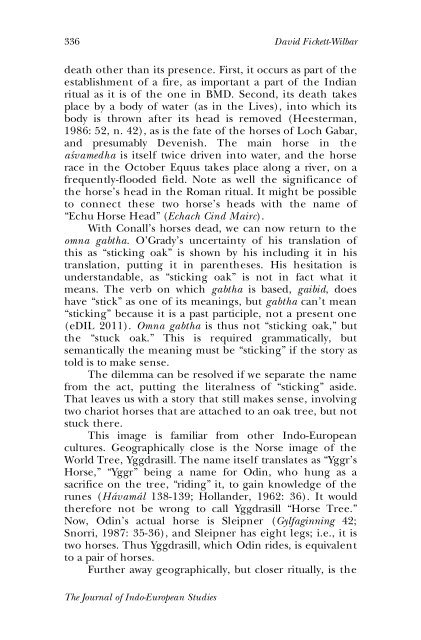Ritual Details of the Irish Horse Sacrifice in Betha ... - Clarkriley.com
Ritual Details of the Irish Horse Sacrifice in Betha ... - Clarkriley.com
Ritual Details of the Irish Horse Sacrifice in Betha ... - Clarkriley.com
You also want an ePaper? Increase the reach of your titles
YUMPU automatically turns print PDFs into web optimized ePapers that Google loves.
336 David Fickett-Wilbar<br />
death o<strong>the</strong>r than its presence. First, it occurs as part <strong>of</strong> <strong>the</strong><br />
establishment <strong>of</strong> a fire, as important a part <strong>of</strong> <strong>the</strong> Indian<br />
ritual as it is <strong>of</strong> <strong>the</strong> one <strong>in</strong> BMD. Second, its death takes<br />
place by a body <strong>of</strong> water (as <strong>in</strong> <strong>the</strong> Lives), <strong>in</strong>to which its<br />
body is thrown after its head is removed (Heesterman,<br />
1986: 52, n. 42), as is <strong>the</strong> fate <strong>of</strong> <strong>the</strong> horses <strong>of</strong> Loch Gabar,<br />
and presumably Devenish. The ma<strong>in</strong> horse <strong>in</strong> <strong>the</strong><br />
aßvamedha is itself twice driven <strong>in</strong>to water, and <strong>the</strong> horse<br />
race <strong>in</strong> <strong>the</strong> October Equus takes place along a river, on a<br />
frequently-flooded field. Note as well <strong>the</strong> significance <strong>of</strong><br />
<strong>the</strong> horse’s head <strong>in</strong> <strong>the</strong> Roman ritual. It might be possible<br />
to connect <strong>the</strong>se two horse’s heads with <strong>the</strong> name <strong>of</strong><br />
“Echu <strong>Horse</strong> Head” (Echach C<strong>in</strong>d Mairc).<br />
With Conall’s horses dead, we can now return to <strong>the</strong><br />
omna gabtha. O’Grady’s uncerta<strong>in</strong>ty <strong>of</strong> his translation <strong>of</strong><br />
this as “stick<strong>in</strong>g oak” is shown by his <strong>in</strong>clud<strong>in</strong>g it <strong>in</strong> his<br />
translation, putt<strong>in</strong>g it <strong>in</strong> paren<strong>the</strong>ses. His hesitation is<br />
understandable, as “stick<strong>in</strong>g oak” is not <strong>in</strong> fact what it<br />
means. The verb on which gabtha is based, gaibid, does<br />
have “stick” as one <strong>of</strong> its mean<strong>in</strong>gs, but gabtha can’t mean<br />
“stick<strong>in</strong>g” because it is a past participle, not a present one<br />
(eDIL 2011). Omna gabtha is thus not “stick<strong>in</strong>g oak,” but<br />
<strong>the</strong> “stuck oak.” This is required grammatically, but<br />
semantically <strong>the</strong> mean<strong>in</strong>g must be “stick<strong>in</strong>g” if <strong>the</strong> story as<br />
told is to make sense.<br />
The dilemma can be resolved if we separate <strong>the</strong> name<br />
from <strong>the</strong> act, putt<strong>in</strong>g <strong>the</strong> literalness <strong>of</strong> “stick<strong>in</strong>g” aside.<br />
That leaves us with a story that still makes sense, <strong>in</strong>volv<strong>in</strong>g<br />
two chariot horses that are attached to an oak tree, but not<br />
stuck <strong>the</strong>re.<br />
This image is familiar from o<strong>the</strong>r Indo-European<br />
cultures. Geographically close is <strong>the</strong> Norse image <strong>of</strong> <strong>the</strong><br />
World Tree, Yggdrasill. The name itself translates as “Yggr’s<br />
<strong>Horse</strong>,” “Yggr” be<strong>in</strong>g a name for Od<strong>in</strong>, who hung as a<br />
sacrifice on <strong>the</strong> tree, “rid<strong>in</strong>g” it, to ga<strong>in</strong> knowledge <strong>of</strong> <strong>the</strong><br />
runes (Hávamál 138-139; Hollander, 1962: 36). It would<br />
<strong>the</strong>refore not be wrong to call Yggdrasill “<strong>Horse</strong> Tree.”<br />
Now, Od<strong>in</strong>’s actual horse is Sleipner (Gylfag<strong>in</strong>n<strong>in</strong>g 42;<br />
Snorri, 1987: 35-36), and Sleipner has eight legs; i.e., it is<br />
two horses. Thus Yggdrasill, which Od<strong>in</strong> rides, is equivalent<br />
to a pair <strong>of</strong> horses.<br />
Fur<strong>the</strong>r away geographically, but closer ritually, is <strong>the</strong><br />
The Journal <strong>of</strong> Indo-European Studies



